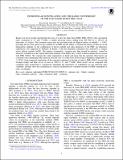| dc.contributor.author | Akiyama, Kazunori | |
| dc.contributor.author | Johnson, Michael D. | |
| dc.date.accessioned | 2016-12-22T16:37:44Z | |
| dc.date.available | 2016-12-22T16:37:44Z | |
| dc.date.issued | 2016-06 | |
| dc.date.submitted | 2016-05 | |
| dc.identifier.issn | 2041-8213 | |
| dc.identifier.issn | 2041-8213 | |
| dc.identifier.uri | http://hdl.handle.net/1721.1/106128 | |
| dc.description.abstract | Keane et al. have recently reported the discovery of a new fast radio burst (FRB), FRB 150418, with a promising radio counterpart at 5.5 and 7.5 GHz—a rapidly decaying source, falling from 200–300 μJy to 100 μJy on timescales of ~6 days. This transient source may be associated with an elliptical galaxy at redshift z = 0.492, providing the first firm spectroscopic redshift for an FRB and the ability to estimate the density of baryons in the intergalactic medium via the combination of known redshift and radio dispersion of the FRB. An alternative explanation, first suggested by Williams & Berger, is that the identified counterpart may instead be a compact active galactic nucleus (AGN). The putative counterpart's variation may then instead be extrinsic, caused by refractive scintillation in the ionized interstellar medium of the Milky Way, which would invalidate the association with FRB 150418. We examine this latter explanation in detail and show that the reported observations are consistent with scintillating radio emission from the core of a radio-loud AGN having a brightness temperature T[subscript b] ≳ 10[superscript 9] K. Using numerical simulations of the expected scattering for the line of sight to FRB 150418, we provide example images and light curves of such an AGN at 5.5 and 7.5 GHz. These results can be compared with continued radio monitoring to conclusively determine the importance of scintillation for the observed radio variability, and they show that scintillation is a critical consideration for continued searches for FRB counterparts at radio wavelengths. | en_US |
| dc.description.sponsorship | Japan Society for the Promotion of Science (Postdoctoral Fellowships for Research Abroad) | en_US |
| dc.description.sponsorship | National Science Foundation (U.S.) | en_US |
| dc.language.iso | en_US | |
| dc.publisher | IOP Publishing | en_US |
| dc.relation.isversionof | http://dx.doi.org/10.3847/2041-8205/824/1/l3 | en_US |
| dc.rights | Article is made available in accordance with the publisher's policy and may be subject to US copyright law. Please refer to the publisher's site for terms of use. | en_US |
| dc.source | American Astronomical Society | en_US |
| dc.title | INTERSTELLAR SCINTILLATION AND THE RADIO COUNTERPART OF THE FAST RADIO BURST FRB 150418 | en_US |
| dc.type | Article | en_US |
| dc.identifier.citation | Akiyama, Kazunori, and Michael D. Johnson. “INTERSTELLAR SCINTILLATION AND THE RADIO COUNTERPART OF THE FAST RADIO BURST FRB 150418.” The Astrophysical Journal 824.1 (2016): L3. © 2016 The American Astronomical Society | en_US |
| dc.contributor.department | Haystack Observatory | en_US |
| dc.contributor.mitauthor | Akiyama, Kazunori | |
| dc.relation.journal | The Astrophysical Journal Letters | en_US |
| dc.eprint.version | Final published version | en_US |
| dc.type.uri | http://purl.org/eprint/type/JournalArticle | en_US |
| eprint.status | http://purl.org/eprint/status/PeerReviewed | en_US |
| dspace.orderedauthors | Akiyama, Kazunori; Johnson, Michael D. | en_US |
| dspace.embargo.terms | N | en_US |
| mit.license | PUBLISHER_POLICY | en_US |
| mit.metadata.status | Complete | |
